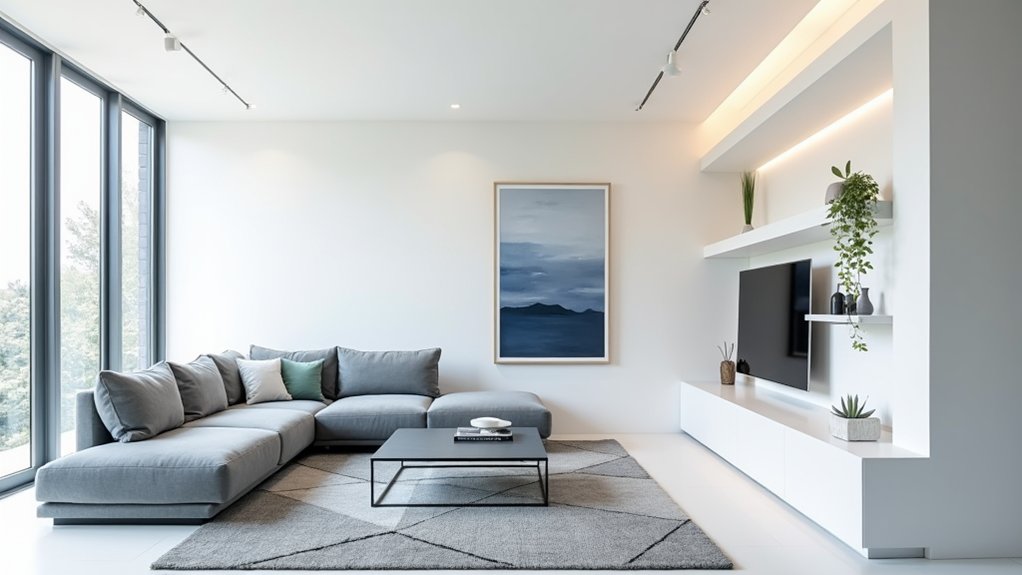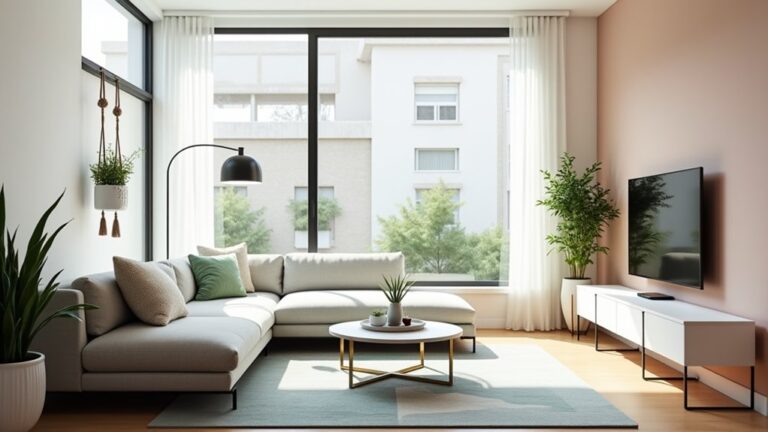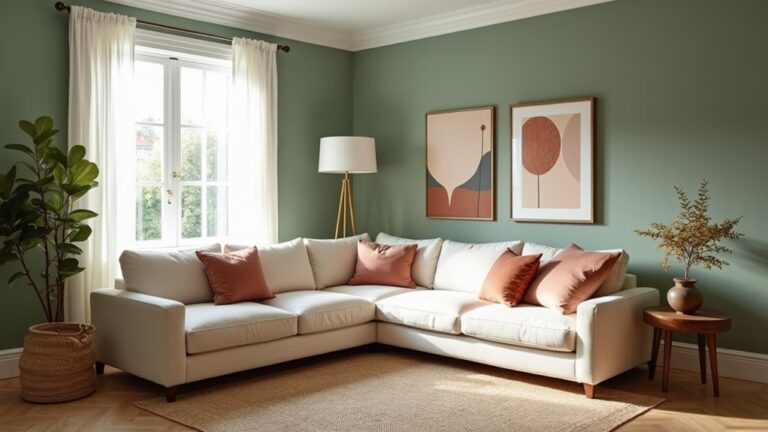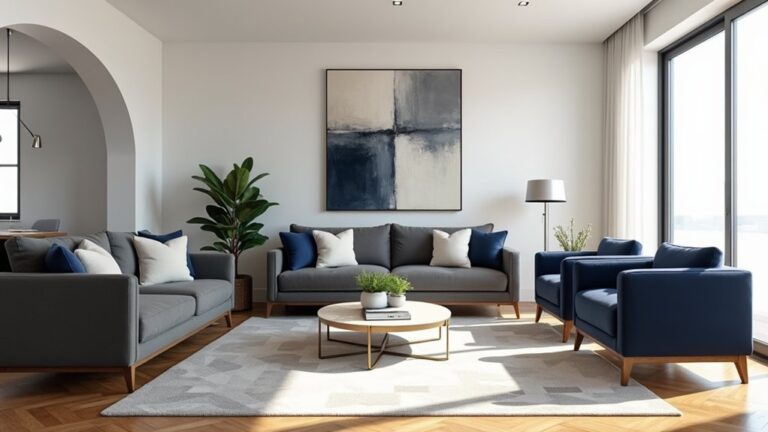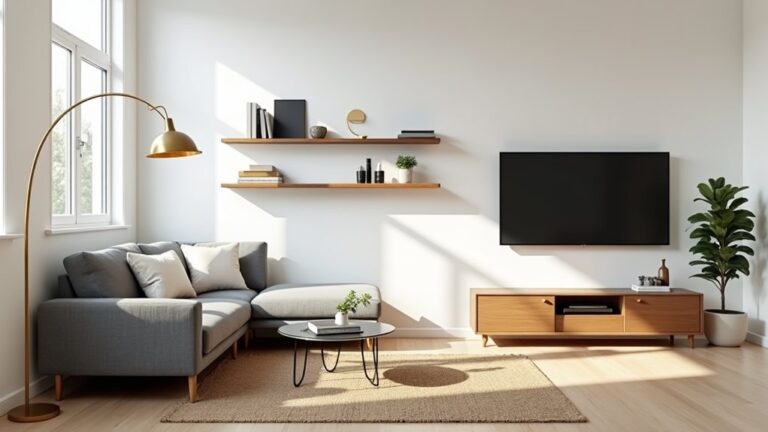Modern design principles offer ideal solutions for small living rooms by maximizing space efficiency and functionality. Through smart furniture choices, like multi-purpose ottomans and wall-mounted desks, every square foot serves multiple roles. Strategic lighting and color schemes, particularly light tones and reflective surfaces, create an illusion of spaciousness while maintaining sophisticated aesthetics. Open floor plans and intentional furniture placement establish natural flow, eliminating visual barriers that could make spaces feel cramped. Contemporary storage solutions seamlessly integrate into the design, keeping clutter minimal. Discover how modern design elements can transform your compact living space into a stunning, functional sanctuary.
Key Takeaways
- Modern designs emphasize clean lines and minimal ornamentation, making small spaces appear less cluttered and more open.
- Multi-functional furniture solutions maximize space efficiency while maintaining style and practicality in compact rooms.
- Contemporary lighting techniques and strategic color choices create an illusion of larger spaces through balanced illumination.
- Smart storage solutions integrate seamlessly into modern designs, reducing visual clutter while maintaining essential functionality.
- Open-concept layouts and strategic furniture placement create better flow and improve overall space utilization.
Space-Saving Modern Design Benefits
The integration of space-saving modern design elements transforms small living rooms into highly functional, visually expansive spaces.
As urban planning trends shift toward small apartments, these innovative solutions maximize every square foot through multi-purpose furniture, vertical storage, and strategic layout planning.
The result is a sophisticated environment that maintains aesthetic appeal while delivering practical solutions for contemporary living challenges.
Smart lighting solutions enhance the ambiance and perceived spaciousness while providing energy-efficient illumination for modern compact living spaces.
Light and Color Strategies
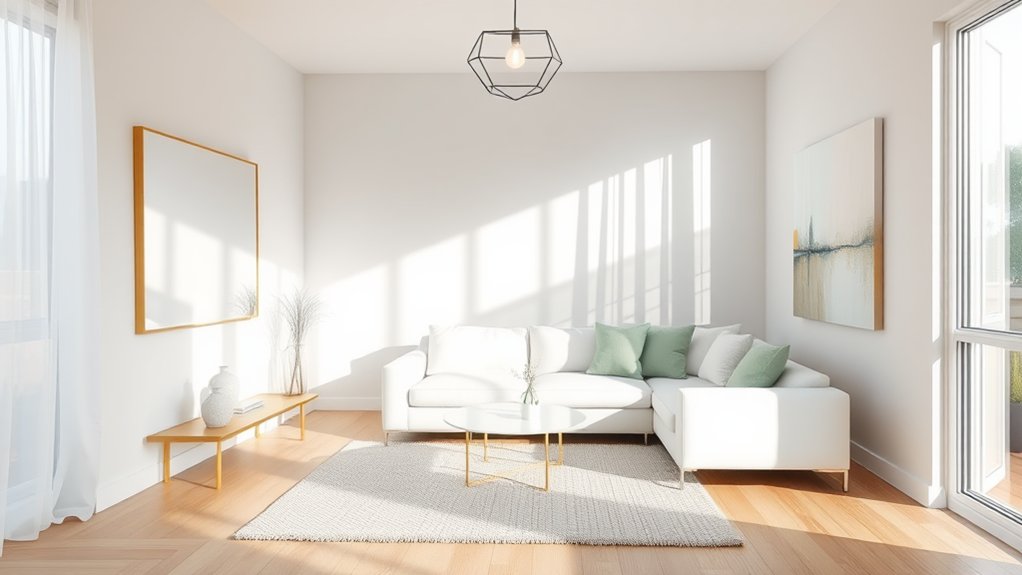
Mastering light and color dynamics plays a crucial role in creating an illusion of spaciousness in compact living rooms.
Strategic use of pastel hues on walls reflects natural light effectively, while layered soft lighting eliminates harsh shadows that can make spaces feel confined.
Light-toned furniture and reflective surfaces amplify brightness, while carefully chosen accent colors add depth without overwhelming the room's proportions.
Daylight-mimicking bulbs create a natural ambiance in rooms with limited window exposure.
Multi-functional Furniture Solutions
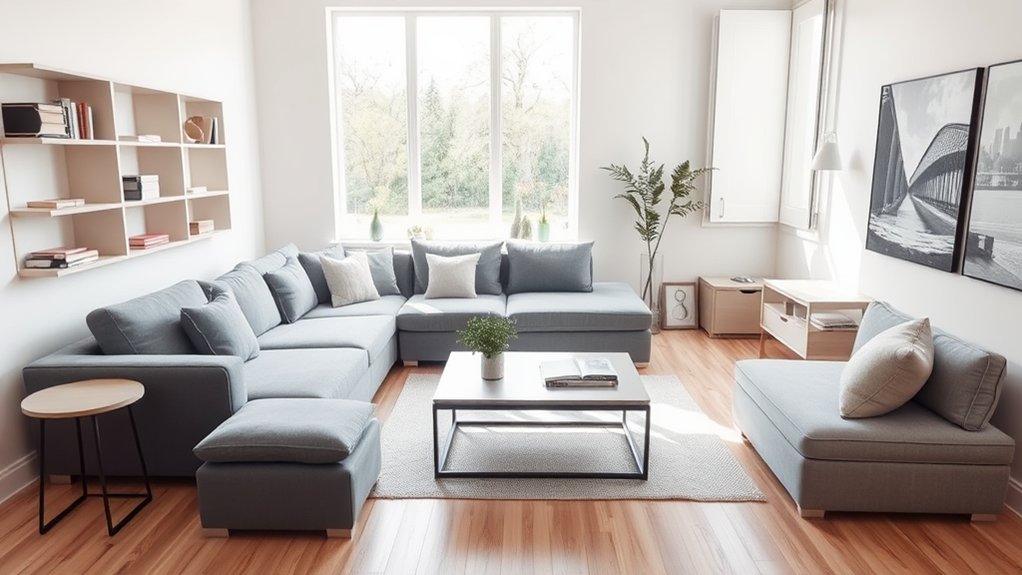
Beyond thoughtful color selection and lighting, smart furniture choices define successful small-space design.
Current furniture trends emphasize pieces that serve multiple purposes: ottomans with hidden storage, expandable dining tables, and modular sofas that adapt to changing needs. Versatile room dividers double as shelving units, while wall-mounted desks fold away when not in use, maximizing every square foot of living space.
Clean lines and shapes enhance visual clarity while drawing attention to the most functional elements within your living room.
Creating Visual Flow
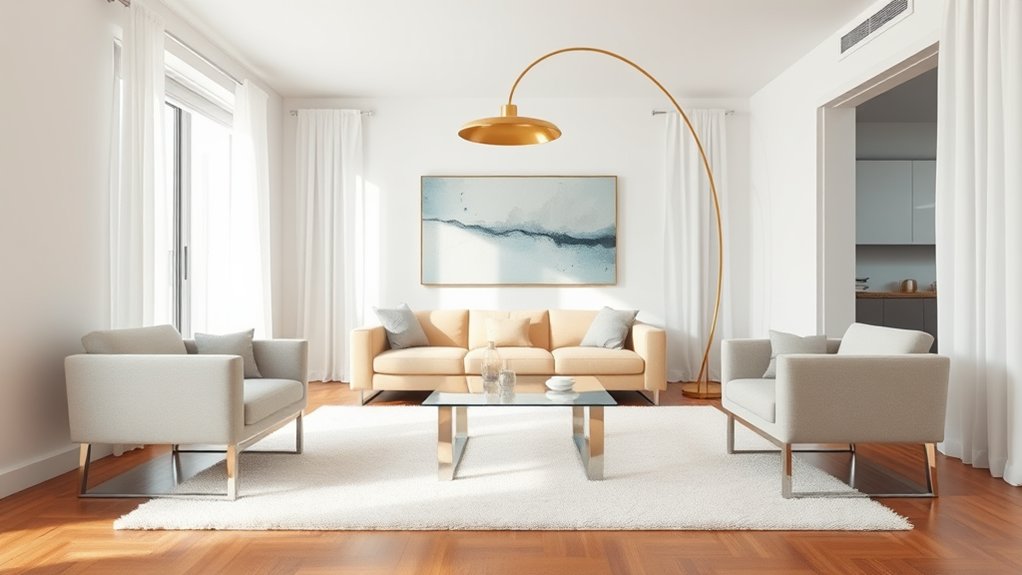
Creating seamless visual flow in a small living room begins with embracing an open floor plan that eliminates unnecessary walls and barriers between spaces.
Strategic furniture placement plays a vital role, with pieces arranged to create natural pathways and sightlines that guide the eye through the room. When furniture and architectural elements work in harmony, the result is a space that feels more expansive and intentionally designed, regardless of its actual square footage.
Open Floor Plans
Developing an open floor plan stands as one of the most effective strategies for maximizing space in small living rooms.
This open concept approach eliminates unnecessary walls and barriers, creating a seamless flow between functional areas.
Smart floor planning allows for flexible furniture arrangements while maintaining clear sight lines throughout the space, making the room feel substantially larger and more adaptable to various activities.
Strategic Furniture Placement
While open floor plans set the foundation for a spacious feeling, strategic furniture placement plays an equally crucial role in maximizing small living room potential.
The key lies in creating purposeful room layouts that direct traffic flow naturally. Position larger pieces against walls, maintain clear pathways between seating areas, and arrange furniture to establish conversational groupings that enhance both functionality and visual harmony.
Smart Storage Options
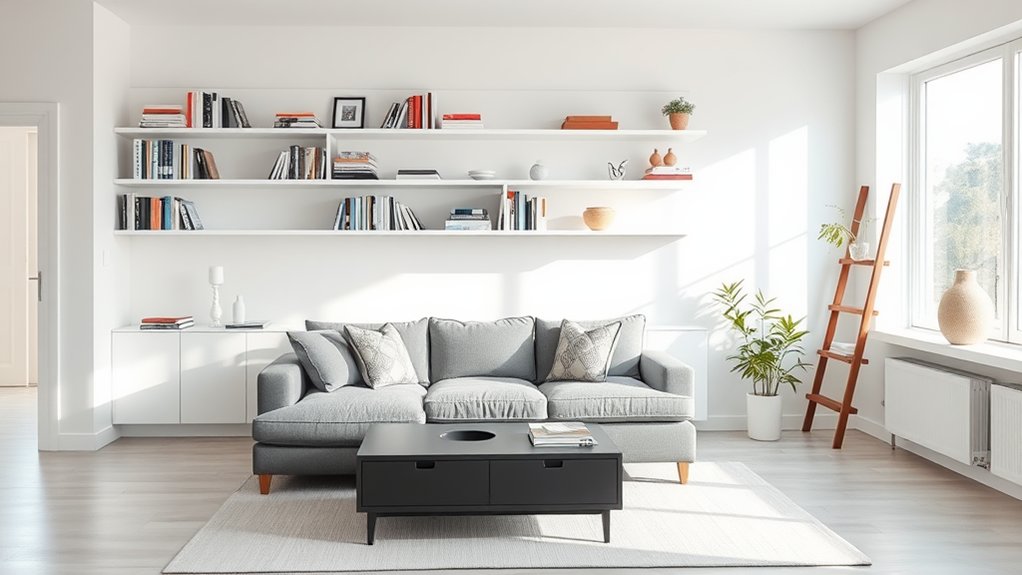
Smart storage solutions serve as the cornerstone of any well-designed small living room, transforming cluttered spaces into sleek, functional havens.
Modern designs incorporate hidden compartments within ottomans and coffee tables, while strategically placed secret shelves blend seamlessly into walls. These innovative storage elements maintain visual simplicity while maximizing space efficiency, essential for contemporary urban living environments.
Modern Materials and Textures
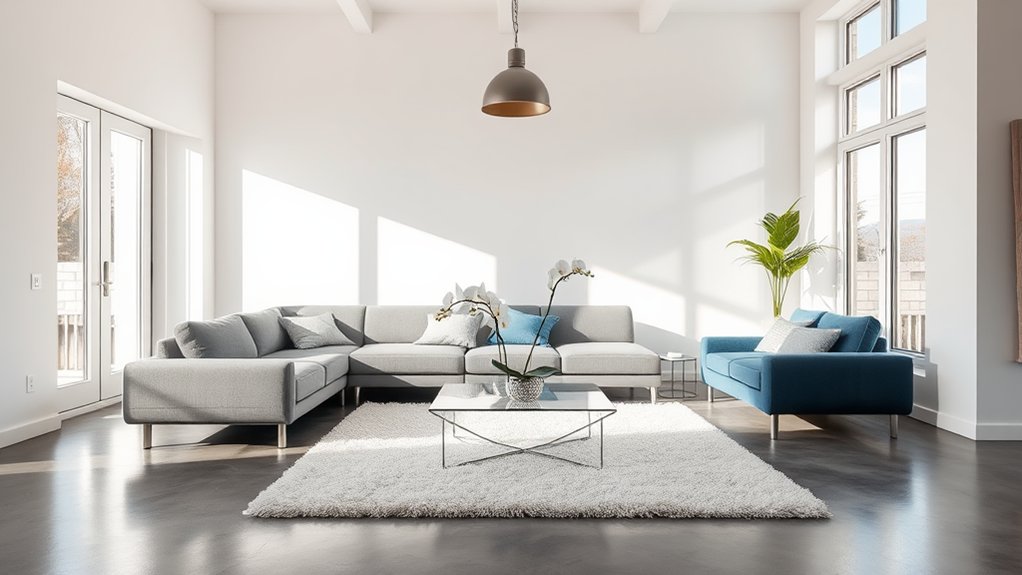
Contemporary living room design embraces the interplay of clean geometric forms with metallic accents, creating a sophisticated aesthetic that maximizes visual space.
The strategic incorporation of brushed steel, chrome, or brass elements through fixtures, furniture frames, or decorative pieces adds refined glamour while maintaining minimalist principles.
Natural materials like wood and stone merge seamlessly with industrial elements, establishing a balanced, modern environment that feels both cutting-edge and welcoming.
Clean Lines and Metallics
Clean lines and metallic accents define the essence of modern small living room design, creating an environment that feels both sophisticated and spacious.
The strategic use of geometric patterns in furniture and décor, combined with brushed metal fixtures and chrome details, adds depth without overwhelming the space.
These elements work together to reflect light and establish visual continuity throughout the room.
Natural and Industrial Blends
Through the intentional fusion of raw industrial elements and organic materials, modern small living rooms achieve an enchanting balance that speaks to both urban sophistication and natural comfort.
This design approach, particularly popular in urban lofts, combines exposed metal fixtures and concrete surfaces with earthy accents like reclaimed wood, woven textiles, and potted plants to create spaces that feel simultaneously refined and grounded.
Minimalist Decor Principles
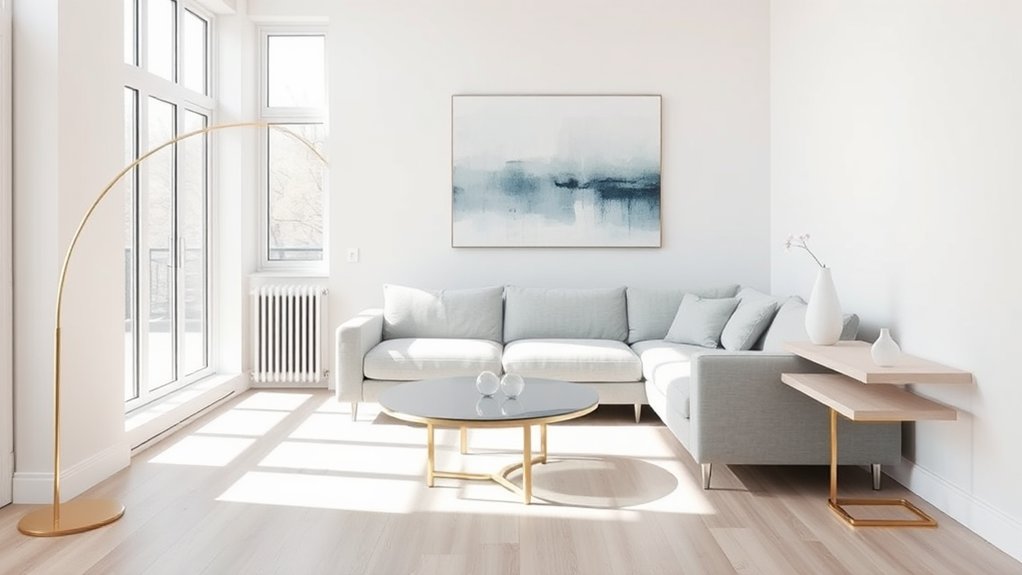
Minimalist decor principles transform small living rooms by embracing simplicity and purposeful design choices.
Among current decor trends, this interior style emphasizes clean lines, uncluttered spaces, and carefully curated furniture pieces.
Each element serves both form and function, eliminating unnecessary ornamentation.
The result is a serene, sophisticated space where essential items become statement pieces through thoughtful placement and pristine presentation.
Frequently Asked Questions
How Much Does a Modern Small Living Room Renovation Typically Cost?
Modern small living room renovation costs typically range from $10,000 to $30,000, depending on materials, labor, and design complexity. Budget planning should account for furniture, lighting, and architectural modifications.
Can Modern Design Work Well With Vintage or Antique Pieces?
Modern design beautifully complements vintage pieces through mixed decor approaches. The eclectic style creates striking contrasts between clean lines and antique character, offering sophisticated, personalized spaces with timeless appeal.
What Are the Best Floor Plan Layouts for Narrow Living Rooms?
Long, narrow spaces benefit from strategic furniture placement along walls, using room dividers to create distinct zones, and maintaining clear pathways through the center for ideal flow.
How Do I Incorporate Technology Without Compromising the Modern Aesthetic?
Integrate smart furniture with built-in charging capabilities and conceal technology using hidden outlets behind panels. Select sleek media consoles, motorized blinds, and wireless speakers that complement contemporary aesthetics.
Which Modern Design Trends Have the Longest-Lasting Appeal for Resale Value?
While trends come and go, timeless designs like clean-lined furniture, neutral colors, and minimalist architectural elements consistently maintain value. Open-concept layouts and natural materials particularly appeal to future buyers.
Conclusion
Modern design for small living spaces mirrors the elegant efficiency of a Swiss timepiece, where every element serves a purpose while maintaining aesthetic harmony. Through strategic space planning, multi-functional furnishings, and minimalist principles, contemporary design transforms spatial limitations into advantages. Research shows that rooms featuring modern design elements appear up to 30% larger to viewers. The fusion of form and function in modern design creates an environment that maximizes both physical space and visual impact.

